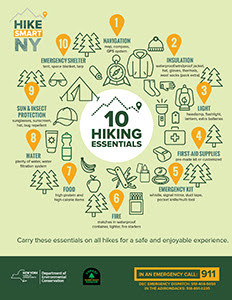
Summer recreation is fun and exciting. It can also be challenging and dangerous. Whether you’re going for a hike, a bike, a paddle, or fishing, Hike Smart NY can help you prepare with a list of 10 essentials, guidance on what to wear, and tips for planning your trip with safety and sustainability in mind.
Timing is Everything
It’s easy to lose track of time in the outdoors. There is a lot to think about and plenty of opportunity for your mind to wander. Becoming fully immersed in your outdoor experience is great but timing is everything when it comes to outdoor safety. Consider the following time markers when planning your trip.
- Sunrise and sunset: While planning your hike, check what time the sun rises and sets so you can plan your timeline around the amount of daylight you have to work with. Avoid hiking in the dark if possible.
- Hike time: Based on how quickly you normally hike and the distance of your trip, calculate how long it will realistically take you to complete the hike, and be sure to give yourself some wiggle room.
- Start and end times: Choose when to start your hike to maximize daylight and determine when you need to or expect to be done based on your hike time. Share those times with a trusted friend or relative.
- Turnaround time: Your turnaround time is the time you need to start heading back to the trailhead in order to make it by your pre-determined end time. Stick to your turnaround time, even if you haven’t made it to your destination, and don’t assume that hiking back will take less time than hiking in.
Leave No Trace
Follow the Seven Principles of Leave No Trace to maintain minimal impact on the environment and the natural resources of the Adirondacks. Use proper trail etiquette to ensure an enjoyable experience for yourself and others and tread lightly!
It can be tempting to go your own way in the wilderness but sticking to designated trails has many benefits. Not only does it minimize your risk of getting lost or running into unexpected hazards, it helps maintain the local ecosystem too. By concentrating impacts to designated trails, vegetation and local wildlife are left to flourish. This can be especially important in areas of rare or fragile vegetation, like some of the alpine plant zones in the Adirondack High Peaks region. On rocky summits, look for directional rock cairns or paint blazes to help you find your way. If you encounter mud on the trail, walk directly through it instead of around it to help maintain the integrity of trail edges and minimize trail widening.
